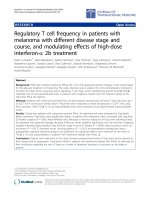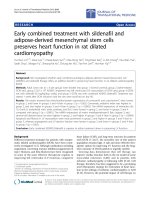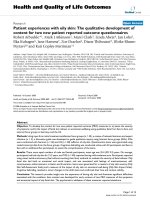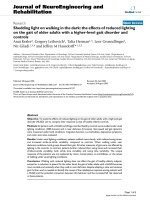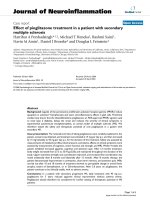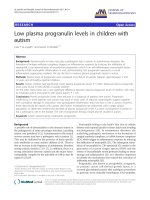báo cáo hóa học: " Gemcitabine combined with oxaliplatin in pretreated patients with malignant pleural mesothelioma: an observational study" pot
Bạn đang xem bản rút gọn của tài liệu. Xem và tải ngay bản đầy đủ của tài liệu tại đây (417.8 KB, 7 trang )
BioMed Central
Page 1 of 7
(page number not for citation purposes)
Journal of Occupational Medicine
and Toxicology
Open Access
Research
Gemcitabine combined with oxaliplatin in pretreated patients with
malignant pleural mesothelioma: an observational study
Athanasios Xanthopoulos, Torsten T Bauer*, Torsten G Blum, Jens Kollmeier,
Nicolas Schönfeld and Monika Serke
Address: Respiratory Diseases Clinic Heckeshorn, Department of Pneumology, HELIOS Klinikum Emil von Behring, Berlin, Germany
Email: Athanasios Xanthopoulos - ; Torsten T Bauer* - ;
Torsten G Blum - ; Jens Kollmeier - ;
Nicolas Schönfeld - ; Monika Serke -
* Corresponding author
Abstract
Background: The aim of this study was to investigate the efficacy and safety of oxaliplatin ±
gemcitabine in patients with diffuse malignant pleural mesothelioma (MPM) pretreated with
pemetrexed.
Methods: The study enrolled consecutive patients with relapsed MPM, all of them pretreated with
a platin-pemetrexed-based chemotherapy. Oxaliplatin 80 mg/m
2
was administered as monotherapy
or in combination with gemcitabine 1000 mg/m
2
given on day 1 and 8. Cycles were repeated every
21 days. The primary endpoints were response rate and disease control rate. Secondary endpoints
included overall survival (OS), time to tumour progression (TTP), progression-free survival (PFS),
time to treatment failure (TTF), and toxicity.
Results: Between February 2005 and September 2007 29 patients (median age: 65.0 years, World
Health Organisation (WHO) performance status: 0–3) were enrolled. The follow-up period
encompassed 5.4 to 97.4 weeks (median: 24.3 weeks). Out of these 29 patients, 15 were treated
in second, 10 in third, 3 in fourth and 1 in fifth line, respectively. The majority of the patients
received the combination oxaliplatin and gemcitabine (n = 25 vs. 4; 86.2 vs. 13.8%).
The median overall survival (OS) was 71.7 weeks (30.6–243.3 weeks), whereas survival from the
start of oxaliplatin/gemcitabine-treatment was 24.3 weeks (5.4–97.3 weeks). Median time to
tumour progression (TTP) was 9.3 weeks (3.0–67.6 weeks).
Partial response (PR) was observed in 2 patients (6.9%), stable disease (SD) for at least three
courses of treatment in 11 patients (37.9%). Thus, disease control rate was 44.8%, whereas 16 of
29 patients exhibited progressive disease (55.2%).
The toxicity profile was favourable, with no WHO grade 4-toxicities, only few dose-reductions
were performed due to non-symptomatic haematotoxicities (neutropenia, thrombopenia). Mild
WHO grade 2 neurotoxicity was seen in 6 patients.
Conclusion: Pemetrexed-pretreated patients with progressive MPM may benefit from a
consecutive chemotherapy with oxaliplatin and gemcitabine without significant toxicity.
Published: 18 December 2008
Journal of Occupational Medicine and Toxicology 2008, 3:34 doi:10.1186/1745-6673-3-34
Received: 9 September 2008
Accepted: 18 December 2008
This article is available from: />© 2008 Xanthopoulos et al; licensee BioMed Central Ltd.
This is an Open Access article distributed under the terms of the Creative Commons Attribution License ( />),
which permits unrestricted use, distribution, and reproduction in any medium, provided the original work is properly cited.
Journal of Occupational Medicine and Toxicology 2008, 3:34 />Page 2 of 7
(page number not for citation purposes)
Background
Malignant mesothelioma (MM) is a rare malignant dis-
ease and originates from neoplastic mesothelial cells,
hence, primarily situated to serous membranes of pleura,
peritoneum, pericardium, or testis. Though exhibiting an
aggressive, locally advancing growth pattern, MM expands
clinically unperceived for a long time [1-3]. The age-
adjusted incidence of mesothelioma in 11 industrialized
countries has been recently estimated with 14 to 35 cases
per million per year [4]. In autopsy studies, the frequency
of malignant mesothelioma varies from 0.02 to 0.7%,
with a rate of 0.2% in the largest series. The pleura is more
often involved than the peritoneum, with a predomi-
nance of the right over the left pleura (60:40) [5]. Most
cases of MM can be ascribed to chronic occupational
exposure against asbestos fibres. [6]. Overall, the progno-
sis for patients with malignant pleural mesothelioma
(MPM) is poor. Accordingly, several studies reported con-
sistently 5-year survival rates of less than 1% and revealed
low median survival times for therapy-naive patients of
approximately 8 to 12 months [3,7-9].
Formerly, mesothelioma was thought to be resistant to
chemotherapy. With the initiation of pemetrexed in 2002,
chemotherapy with platin/pemetrexed chemotherapy
became standard for MPM treatment with response rates
of approximately 40%. However, patients relapse during
or after a platin/pemetrexed-based chemotherapy and
therefore may benefit from a complementary chemother-
apy [10].
Gemcitabine (2,2'-difluorodesoxycytidine) is a pyrimi-
dine analogue with activity against a wide range of solid
tumours, including pancreatic carcinoma and non small
cell lung carcinoma [11]. Its mechanism of action, toxic-
ity, and clinical pharmacology have been reviewed exten-
sively [12,13]. Moreover, gemcitabine seems to be active
in MPM [10]. The enantiomer oxaliplatin (Cis-
[oxalate]trans-l-1,2-Diaminocyclohexan) is an antineo-
plastic substance belonging to the class of platin-derivats.
Oxaliplatin has demonstrated activity in the treatment of
advanced tumours, both in combined and in monothera-
peutic regimes. Notably, oxaliplatin has proven to be
active at least in vitro against cisplatin-resistant cell lines
and exhibits clinical activity in the treatment of cisplatin/
carboplatin refractory diseases [14-16].
Schütte and co-workers have previously introduced a
combined chemotherapy with oxaliplatin and gemcitab-
ine as an active first line therapy in MPM [17]. The pri-
mary aim of this study was to evaluate the efficacy as well
as safety of oxaliplatin in combination with gemcitabine
or as a monotherapy in patients with MPM who were pre-
teated with a pemetrexed/platin-combination therapy.
Methods
Inclusion criteria
All consecutive patients with histologically confirmed
advanced MPM and progressive disease after pemetrexed/
platin-based chemotherapy were enrolled in this study.
Further inclusion criteria were: age < 80 years and life
expectancy > 2 months, unidimensional measurable dis-
ease, World Health Organisation (WHO) performance
status of 0–2, and adequate haematologic (absolute neu-
trophil ≥ 1.5 × 10
9
/L, platelets ≥ 100 × 10
9
/l, and hemo-
globin ≥ 9 g/dL), hepatic (bilirubin ≤ 1.2 mg/dL,
transaminases and cholestatic parameters within 2-fold of
upper limit of reference range), and renal (creatinine
clearance ≤ 45 mL/min according to Cockcroft and Gault)
functions. Previous surgery or radiotherapy was allowed
in this study.
Pretreatment evaluation
All patients underwent an accurate medical history. In
addition to a detailed history of working activities and
asbestos exposure, patients underwent a physical exami-
nation, a complete blood count and biochemistry profile,
an ECG, chest X-Ray and chest and upper abdomen CT
scan. Physical examinations were also performed before
each treatment cycle. Bone scan, brain magnet resonance
imaging and upper abdominal ultrasound were per-
formed only if indicated clinically.
Study medication
Initially, all patients received oxaliplatin at a dose of 80
mg/m
2
with or without gemcitabine at a dose of 1000 mg/
m
2
according to the scheme proposed by Schütte and co-
workers [17]. Gemcitabine was diluted in normal saline
and administered intravenously over 30 minutes on days
1 and 8 of each 21-day cycle. Oxaliplatin at a dose of 80
mg/m
2
was diluted in 5% glucose and administered intra-
venously in 3 h on days 1 and 8 of each 21-cycle after the
gemcitabine-administration. Antiemetic prophylaxis was
performed with 5-hydroxytryptamine (HT3) antagonists.
Additional antiemetic agents were used according to the
advice of the treating physician.
The response evaluation was monitored by Chest-X-Ray
after each cycle and computed tomography scan (CT) after
2 or 3 cycles. Treatment in responding patients or patients
with stable disease was continued for a maximum of six
cycles. Both agents were reduced on day 8 to 25% in the
event of grade 3 leukopenia and/or the thrombopenia
between 99 × 10
9
/L and 50 × 10
9
/L. Therapy was omitted
if the absolute neutrophil count (ANC) was less than 0.5
× 10
9
/L or if grade 3 or 4 non-haematologic toxicity
occurred. Treatment was repeated on day 21 if the ANC
was greater than or equal to 1.5 × 10
9
/L and the platelet
count was greater than or equal to 100 × 10
9
/L. Treatment
Journal of Occupational Medicine and Toxicology 2008, 3:34 />Page 3 of 7
(page number not for citation purposes)
was delayed for one week if the ANC and/or platelet
counts fell below these levels.
Response and toxicity evaluation
Tumour response was assessed according to RECIST crite-
ria with evaluation of target lesions at baseline, after every
cycle, and at the end of treatment [18]. Nodular thicken-
ing of the pleura was accepted as a target lesion if the
thickening was at least 2 cm in its greatest perpendicular
diameter. CT-scans were mandatory for evaluation of
intrathoracic lesions.
The primary efficacy endpoints were response rate (differ-
entiated in complete response (CR), partial response
(PR), stable disease (SD), and progressive disease (PD))
and disease control rate (CR+PR+SD), secondary end-
points were: overall survival (OS), which was defined as
time from first diagnosis of MPM to death, survival after
start of treatment (defined as time from first application
of oxaliplatin with or without gemcitabine to death), time
to tumour progression (TTP; defined as time from first
application of oxaliplatin with/without gemcitabine to
first observation of PD), progression-free survival (PFS;
defined as time from first application of oxaliplatin with
or without gemcitabine to first observation of PD or
death), time to treatment failure (TTF; defined as time
from first application of oxaliplatin with or without gem-
citabine to first observation of PD, death, or discontinua-
tion of therapy), and toxicity.
Statistics
All frequencies are reported as number and percentage.
Continuous variables are reported as mean ± standard
deviation and due to the observational design of this
study also as median ± range. Survival analyses were com-
pute as Kaplan-Meier plots with the Statistical package for
Social Sciences (SPSS
®
) on a Microsoft Windows
®
operat-
ing system.
Results
Between February 2005 and September 2007 overall 29
patients (mean age 64.6 years, median 65.0 years, World
Health Organization (WHO) performance status 0–2)
were enrolled. Detailed patients' characteristics are listed
in table 1.
The median interval from the primary diagnosis to the
beginning of the study treatment was 53.4 weeks (7.9–
185.4 weeks). The follow-up period varied from 5.4 to
97.4 weeks (mean 30.0 weeks, median 24.3 weeks). All
patients were pretreated with a platin/pemetrexed-combi-
nation. Out of these 29 patients, 15 were then treated
(within this study) in second (51.7%), 10 in third
(34.5%), 3 in fourth (10.3%), and 1 in fifth line (3.4%),
respectively. Every patient received at least one cycle of
chemotherapy of oxaliplatin with/without gemcitabine.
In the majority of cases oxaliplatin and gemcitabine were
administered as combination therapy (n = 25 patients vs.
4 patients with oxaliplatin monotherapy; 86.2 vs. 13.8%).
The number of chemotherapy cycles ranged from 1 to 6
(mean: 3.0 cycles; median: 3 cycles).
All patients were assessable for response evaluation. The
median OS (from diagnosis of MPM) was 71.7 weeks
(30.6–243.3 weeks), whereas survival from the start of
treatment was 24.3 weeks (5.4–97.3 weeks). Median TTP
added up to 9.3 weeks (3.0–67.6 weeks). PFS and TTF
were equally calculated as 11.7 weeks (3.0–50.4 weeks),
since no therapy had to be discontinued for other reasons
than PD. Kaplan-Meier plots for OS and survival from the
start of treatment are displayed in figure 1 and 2, respec-
tively.
Partial remission (PR) was observed only in 2 patients
(6.9%), stable disease (SD) for at least three courses of
treatment in 11 patients (37.9%). Thus, disease control
Table 1: Patients' characteristics
Patient Characteristics (n = 29) No. (%)
Gender
Male 27 (93.1%)
WHO performance status
0 5 (17.2%)
1 18 (62.1%)
2 3 (10.3%)
3 3 (10.3%)
Asbestos exposure
Yes 17 (58.6%)
No 1 (3.4%)
Not defined 11 (37.9%)
Histologic Type
Epithelial 27 (93.1%)
Sarcomatoid 1 (3.4%)
Biphasic 1 (3.4%)
Journal of Occupational Medicine and Toxicology 2008, 3:34 />Page 4 of 7
(page number not for citation purposes)
rate was 44.8%, whereas 16 of 29 patients suffered prima-
rily progressive disease (55.2%).
A more differentiated depiction of response to current
chemotherapy is given in table 2, correlating it with num-
bers of previous chemotherapy regimens, response to pre-
vious chemotherapy, and current chemotherapy regimen
(combination or monotherapy).
The toxicity profile was included no WHO grade 4-toxici-
ties and only few dose-reductions were performed due to
non-symptomatic haematotoxicity (neutropenia, throm-
bopenia): altogether, 14 episodes of WHO grade 2–3 neu-
tropenia were reported in 10 and 10 episodes of WHO
grade 2–3 thrombocytopenia in 10 patients, respectively.
All haematologic adverse events were rapidly reversible
and did not result in life-threatening complications (e.g.
sepsis or hemorrhage). Minor anemia (WHO grade 1–2)
developed in 3 patients. Mild WHO grade 2-neurotoxicity
was seen in 6 patients (20.7%), renal toxicity was evident
only in 1 patient (3.4%). Besides, 4 patients complained
of fatigue (13.7%; WHO grade 1–2).
Discussion
The major results of our study were: (1) Partial remission
(PR) was unlikely (6.9%) when oxaliplatin/gemcitabine
was used as chemotherapy in multiple pretreated, peme-
trexed-resistent patients with MPM. (2) However, disease
Kaplan-Meier-plot for overall survivalFigure 1
Kaplan-Meier-plot for overall survival.
Journal of Occupational Medicine and Toxicology 2008, 3:34 />Page 5 of 7
(page number not for citation purposes)
control could be achieved in 44.8%, when at least three
cycles of chemotherapy could be applicated. (3) The com-
bination therapy was well tolerated and no WHO grade 4-
toxicities occurred in our patients.
The diagnosis of malignant pleural mesothelioma (MPM)
is still associated with a poor prognosis. The 5-year sur-
vival rates are less than 1% and median survival has been
reported to be as low as 8 to 12 months for therapy-naïve
patients [3,7-9]. The introduction of pemetrexed/platin-
based chemotherapy has improved therapeutic options in
the treatment of MPM. However, no chemotherapy
regime could so far demonstrate a significant efficacy in
patients with relapsed MPM after pemetrexed/platin-
based treatment [10].
Vogelzang and co-workers showed an evident benefit of a
pemetrexed/cisplatin-based chemotherapy for the treat-
ment of MPM with a response rate of 41.3% in contrast to
16.7% response in the control group with cisplatin-mon-
otherapy [19]. A decade ago, a review by this group fig-
ured response rates of MPM to different chemotherapy-
regimes regularly as low as 10 to 20%, with only single,
unconfirmed studies indicating possible higher response
rates [1]. The more recent review by Ellis and associates
concluded, that among other chemotherapeutics for
MPM, older studies with gemcitabine monotherapy
revealed response rates from 0 up to 31% [10]. Schütte
and his colleagues were the first to describe results of the
oxaliplatin/gemcitabine combination for the first line
chemotherapy of MPM. In their multicenter phase II
study, objective responses were measured as follows: par-
tial response in 40% (10/25 patients), stable disease in
Kaplan-Meier-curve for survival from the start of Oxaliplatin with or without gemcitabineFigure 2
Kaplan-Meier-curve for survival from the start of Oxaliplatin with or without gemcitabine.
Journal of Occupational Medicine and Toxicology 2008, 3:34 />Page 6 of 7
(page number not for citation purposes)
24% (6/25 patients), and progressive disease in 36% (9/
25 patients). Median TTP and OS were 7 and 13 months,
respectively.
Since pemetrexed based therapy has become first line
treatment for MPM, we report in our observational study
the efficacy and safety of the previously described oxalipl-
atin/gemcitabine protocol for further therapy in peme-
trexed/platin pretreated patients. Our rationale for
selecting these two agents was first, the favourable
response rate in first line therapy for MPM demonstrated
by Schütte and co-workers [17], and second, the accepta-
ble toxicity-profile and thus possible clinical benefits [11-
17].
All 29 patients included in our study had advanced MPM
with a median interval from primary diagnosis to begin of
study treatment of 53 weeks (8 – 185 weeks) and 1 to 4
preceding chemotherapies (including the pemetrexed/
platin combination). The median OS (beginning from
primary diagnosis) was 72 weeks (31 – 243 weeks) and
the median survival after beginning of study treatment 24
weeks (5 – 97 weeks), respectively. The median TTP was 9
weeks (3 – 68 weeks). PFS and TTF were both 12 weeks (3
– 50 weeks). Partial remission (PR) was expectably low
(6.9%), but overall disease control for at least three cycles
of chemotherapy could be achieved in 44.8%.
Generally, evidence is lacking for second line chemother-
apy in relapsing MPM in literature. A most recently pub-
lished paper by Jassem and his group compared the
outcome of pemetrexed in second line treatment with best
supportive care (BSC) in previously treated patients. In
this trial median survival after enrolment was 14.5
months in the pemetrexed plus BSC group vs. 9.7 months
in the BSC group (p = 0.74). TTP, PFS and TTF differed sig-
nificantly in both groups, favouring the pemetrexed group
[20].
In a post-study analysis, Vogelzang and co-workers deter-
mined the benefit of a second-line chemotherapy in a sub-
group of patients treated with pemetrexed/cisplatin or
cisplatin. They found a prolonged survival following a sec-
ond line chemotherapy. However, whether this effect
could be attributed to the second line chemotherapy or
the prolonged survival caused by the natural history of the
tumour could not be demonstrated with statistical signif-
icance. Agents used for second line chemotherapy
included gemcitabine, vinorelbine, doxorubicin, and epi-
rubicin in mono- or combination therapy [21].
Porta and colleagues investigated the anti-tumour activity
of raltitrexed and oxaliplatin given as a second line regime
in a series of 14 patients. The study was prematurely dis-
continued because no response according to the given
endpoints response rate, TTP and OS was observed [22].
In contrast, Fizazi and his group observed a median sur-
vival of 44 weeks from the start of treatment and a median
survival of 226 weeks from the primary diagnosis in 15
patients receiving a second line chemotherapy with the
same regime of raltitrexed and oxaliplatin [23].
The toxicities of the combination oxaliplatin/gemcitabine
as well as of the monotherapy with oxaliplatin were very
acceptable in our study – in accordance with the low tox-
icities reported in the first line therapy [17]. In general,
chemotherapy was tolerated well by all patients. Mild hae-
matologic toxicities were common but not associated
with complications or even life-threatening events. Solely
peripheral neuropathy, fatigue and mild renal impair-
ment were observed.
This study has limitations due to its observational design
and heterogeneity of the patients included. However, no
standard therapy has been established as second line or
beyond and a structured observational approach may
help to foster the understanding of efficacy and safety in
this clinical setting. Second, we reported all patients
receiving oxaliplatin/gemcitabine therapy at any stage of
the disease. This method may reduce applicability of your
results in terms of efficacy as a second line therapy, but
results in more confident results regard drug safety. Third,
Table 2: Response to current chemotherapy with regard to previous chemotherapy regimens, response to previous chemotherapy,
and current chemotherapy regimen (combination or monotherapy).
Numbers of previous chemotherapy regimens Response to previous chemotherapy Current chemotherapy regimen
Response to current
chemotherapy
1 2 3 4 PR SD PD Oxaliplatin and
gemcitabine
Oxaliplatin
Partial response 2 0 0 0 0 1 1 2 0
Stable disease 6 5 0 0 0 3 8 10 1
Progressive disease 7 5 3 1 0 3 13 13 3
Journal of Occupational Medicine and Toxicology 2008, 3:34 />Page 7 of 7
(page number not for citation purposes)
the comparison of your results with other second line
studies in MPM is difficult because patients' characteris-
tics, employed chemotherapy regimens, methods of
response evaluation, and the time from primary diagnosis
to start of second line chemotherapy do vary widely.
Conclusion
Patients with relapsed MPM, refractory to pemetrexed/
platin-pretreatment may benefit from a consecutive ther-
apy with oxaliplatin and gemcitabine with a disease con-
trol rate of 45% with the absence of WHO grad 4-
toxicities. Since now no recommendations based on pro-
spective, randomized trials exist regarding further therapy
in these patients, oxaliplatin/gemcitabine can be per-
ceived as an option until these data are available. Since the
incidence of MPM will even increase over the next 15
years all centers treating patients with MPM will need to
establish also a structured approach for further therapy of
patients initially subjected to pemetrexed/platin combi-
nation chemotherapy.
Competing interests
The authors declare that they have no competing interests.
Authors' contributions
Athanasios Xanthopoulos was responsible for collection
of patient data, initial data analysis and contributed to the
manuscript. Torsten Bauer contributed to the study design
and helped writing the manuscript. Torsten Blum per-
formed final statistical analysis and drafted the manu-
script. Jens Kollmeier and Nicolas Schönfeld included
patients, helped with data collection and analysis and
reviewed the manuscript. Monika Serke guided therapies,
supervised data collection, kept the continuously growing
database and edited the manuscript.
All authors read and approved the final manuscript.
Acknowledgements
We would like to thank all clinical staff not mentioned as an author for the
help in this structured approach. We are especially indebted to our study
nurses Sabine Widdrath and Carmen Sommerfeld who helped extensively
with patient and data management.
References
1. Ong ST, Vogelzang NJ: Chemotherapy in malignant pleural
mesothelioma. A review. J Clin Oncol 1996, 14:1007-1017.
2. Robinson BWS, Lake RA: Advances in Malignant Mesothelioma.
The New England Journal of Medicine 2005, 353:1591-1603.
3. Ruffie P, Feld R, Minkin S, Cormier Y, Boutan-Laroze A, Ginsberg R,
Ayoub J, Shepherd FA, Evans WK, Figueredo A, et al.: Diffuse malig-
nant mesothelioma of the pleura in Ontario and Quebec: a
retrospective study of 332 patients. J Clin Oncol 1989,
7:1157-1168.
4. Tossavainen A: Global use of asbestos and the incidence of
mesothelioma. Int J Occup Environ Health 2004, 10:22-25.
5. Hillerdal G: Malignant mesothelioma 1982: review of 4710
published cases. Br J Dis Chest 1983, 77:321-343.
6. LaDou J: The asbestos cancer epidemic. Environ Health Perspect
2004, 112:285-290.
7. Ceresoli GL, Locati LD, Ferreri AJ, Cozzarini C, Passoni P, Melloni G,
Zannini P, Bolognesi A, Villa E: Therapeutic outcome according
to histologic subtype in 121 patients with malignant pleural
mesothelioma. Lung Cancer 2001, 34:279-287.
8. Aziz T, Jilaihawi A, Prakash D: The management of malignant
pleural mesothelioma; single centre experience in 10 years.
Eur J Cardiothorac Surg 2002, 22:298-305.
9. Harvey JC, Fleischman EH, Kagan AR, Streeter OE: Malignant pleu-
ral mesothelioma: a survival study. J Surg Oncol 1990, 45:40-42.
10. Ellis P, Davies AM, Evans WK, Haynes AE, Lloyd NS: The use of
chemotherapy in patients with advanced malignant pleural
mesothelioma: a systematic review and practice guideline. J
Thorac Oncol 2006, 1:591-601.
11. Kaye SB: Gemcitabine: current status of phase I and II trials.
J Clin Oncol 1994, 12:1527-1531.
12. Lund B, Kristjansen PE, Hansen HH: Clinical and preclinical activ-
ity of 2',2'-difluorodeoxycytidine (gemcitabine). Cancer Treat
Rev 1993, 19:45-55.
13. Abratt RP, Bezwoda WR, Falkson G, Goedhals L, Hacking D, Rugg
TA: Efficacy and safety profile of gemcitabine in non-small-
cell lung cancer: a phase II study. J Clin Oncol 1994,
12:1535-1540.
14. Becouarn Y, Ychou M, Ducreux M, Borel C, Bertheault-Cvitkovic F,
Seitz JF, Nasca S, Nguyen TD, Paillot B, Raoul JL, et al.: Phase II trial
of oxaliplatin as first-line chemotherapy in metastatic color-
ectal cancer patients. Digestive Group of French Federation
of Cancer Centers. J Clin Oncol 1998, 16:2739-2744.
15. Connors TA, Jones M, Ross WC, Braddock PD, Khokhar AR, Tobe
ML: New platinum complexes with anti-tumour activity.
Chem Biol Interact 1972, 5:415-424.
16. de Gramont A, Figer A, Seymour M, Homerin M, Hmissi A, Cassidy J,
Boni C, Cortes-Funes H, Cervantes A, Freyer G, et al.: Leucovorin
and fluorouracil with or without oxaliplatin as first-line treat-
ment in advanced colorectal cancer. J Clin Oncol 2000,
18:2938-2947.
17. Schutte W, Blankenburg T, Lauerwald K, Schreiber J, Bork I, Wolls-
cgkaeger B, Treutler D, Schneider CP, Bonner R: A multicenter
phase II study of gemcitabine and oxaliplatin for malignant
pleural mesothelioma. Clin Lung Cancer 2003, 4:294-297.
18. Therasse P, Arbuck SG, Eisenhauer EA, Wanders J, Kaplan RS, Rubin-
stein L, Verweij J, Van GM, van Oosterom AT, Christian MC, et al.:
New guidelines to evaluate the response to treatment in
solid tumors. European Organization for Research and
Treatment of Cancer, National Cancer Institute of the
United States, National Cancer Institute of Canada. J Natl
Cancer Inst 2000, 92:205-216.
19. Vogelzang NJ, Rusthoven JJ, Symanowski J, Denham C, Kaukel E,
Ruffie P, Gatzemeier U, Boyer M, Emri S, Manegold C, et al.: Phase
III study of pemetrexed in combination with cisplatin versus
cisplatin alone in patients with malignant pleural mesotheli-
oma. J Clin Oncol 2003,
21:2636-2644.
20. Jassem J, Ramlau R, Santoro A, Schuette W, Chemaissani A, Hong S,
Blatter J, Adachi S, Hanauske A, Manegold C: Phase III trial of
pemetrexed plus best supportive care compared with best
supportive care in previously treated patients with advanced
malignant pleural mesothelioma. J Clin Oncol 2008,
26:1698-1704.
21. Manegold C, Symanowski J, Gatzemeier U, Reck M, von PJ, Kortsik C,
Nackaerts K, Lianes P, Vogelzang NJ: Second-line (post-study)
chemotherapy received by patients treated in the phase III
trial of pemetrexed plus cisplatin versus cisplatin alone in
malignant pleural mesothelioma. Ann Oncol 2005, 16:923-927.
22. Porta C, Zimatore M, Bonomi L, Imarisio I, Paglino C, Sartore-Bianchi
A, Mutti L: Raltitrexed-Oxaliplatin combination chemother-
apy is inactive as second-line treatment for malignant pleu-
ral mesothelioma patients. Lung Cancer 2005, 48:429-434.
23. Fizazi K, Doubre H, Le CT, Riviere A, Viala J, Daniel C, Robert L, Bar-
thelemy P, Fandi A, Ruffie P: Combination of raltitrexed and
oxaliplatin is an active regimen in malignant mesothelioma:
results of a phase II study. J Clin Oncol 2003, 21:349-354.
